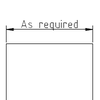The dried cat food is fed down an inclined abs water pipe using a wood drill bit. The pipe inside diameter is approx 20.5mm and the drill bit 18mm. This allows the drill / pipe / motor assembly a small degree of movement to enable self alignment. ABS was chosen as it is much tougher that pvc piping so less likely to be worn away by the drill bit rotating. The drill bit is connected to the motor by simply using the entire motor + gearbox + chuck assembly.
The angle of the assembly is about 25deg above horizontal, calculated by placing cat food in the pipe and tilting it until the food slid out on its own, overcoming friction in the pipe. This way once food has passed the drill bit end it will slide out of the pipe to the cat food bowl. The pipe extends several inches from the end of the drill in order to stop the cat putting a paw up the pipe and being injured by the sharp drill bit end.
The drill bit / motor assembly is positioned by using two springs to hold the drill bit in approximately the correct position in the pipe. In practice this arrangement works well and the springs allow the a small amount of movement during operation. I considered the possibility of sensing a stalled motor (if the feed mechanism should jam) and then reversing the motor momentarily to overcome the jam, but in initial testing I never saw the system become jammed and the motor reverse circuit would have quadrupled the number of power mosfets needed.
The control circuit is based on a picaxe 18x with a mosfet driven straight from an IO port. Power comes from a common 6v 4Ah sealed lead acid battery connected to a shop bought two stage battery charger, probably only needed if the feeder is to run for more than a week. Testing showed that the drill motor needed at least 6 volts to operate successfully, the battery produces about 6.5 volts when charged. However this is too high a voltage for the picaxe 18x chip. I decided to run this near its maximum supply, using 5.5volts to maximise the Vgs drive in order that the power mosfet drain - source resistance was as low as possible when driving the motor (approx 4 amps average).
I used a low power adjustable 3 terminal regulator to get the necessary 5.5 volts for the picaxe. There is a problem with the design of these regulators however ! The low power devices (100mA) use the same circuitry as the 1 amp devices and require 10mA or 10% of the load current just to drive the two voltage setting resistors. This part of the design consumes almost all the overall power taken from the battery, otherwise I calculate the circuit will run for several weeks from a 6Ah battery.
To be continued....



More cat pictures please!